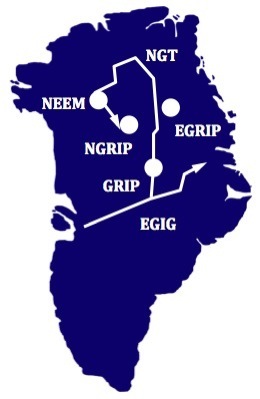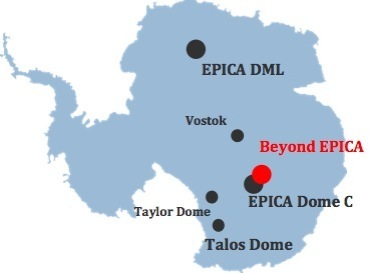Contributions to past and
current ice core projects
Contributions to past and
current ice core projects
EGIG: Revisit of the old Expedition Glaciologique International au Groenland (EGIG) line in 1990-92. During my Master thesis I performed chemical and water isotopic studies on recent firn cores and pit studies along this west-east transect through Central Greenland.
EGRIP: The North East Greenland Ice Stream is a fast flowing ice stream, which is reaching far inland close to the main ice divide. With the EGRIP deep ice core drilling starting in 2016, the history of this important glaciological feature can be explored. Moreover, the low accumulation rate at this site will allow to retrieve a longer Holocene record in bubble ice. This is a prerequisite for obtaining high quality, high-resolution records of aerosol chemistry in this time period, a major goal of the Bern ice core group.
NGT: North Greenland Traverse of the Alfred Wegener Institute for Polar and Marine Research (AWI) in 1993-95. The traverse started at GRIP extending the EGIG line into the little explored northern part of Greenland. My PhD work dealt with chemical and water isotopic studies on shallow ice cores and snow pits along this route covering up to the last 1000 years.
Taylor Dome: The Taylor Dome Ice core drilling through the relatively thin Taylor ice dome provided a more than 100,000 year ice core with no clathrates, best conditions for trace gas studies on this core. During my PostDoc work at Scripps I performed δ13CO2 measurements and was involved in the work on CO2 concentrations, a joint project of Scripps and the University of Bern.
Vostok: Arguably the grandfather of Antarctic deep ice cores, this Russian/French/US project provided climate records back in time for about 400,000 years. During my PostDoc at Scripps I was involved in the analysis of CO2 concentrations on this core.
NGRIP: The North Greenland Ice Core Project deep ice core drilling was carried out in 2000-2004 in the northern part of central Greenland. Due to unexpected basal melting this core failed to provide the intended record back into the Eemain but provided much higher resolution records in the deeper part. Besides aerosol chemistry records on this core my scientific focus in this project is on methane isotopes.
NEEM: The NorthEem deep ice core drilling in the northeastern part of the Greenland ice sheet is a multinational ice core drilling project led by the Center for Ice and Climate, University of Copenhagen. Bedrock has been reached in summer 2010. As was the case for the GRIP and GISP2 ice cores, the bottom-most ice is stratigraphically disturbed, however a unique reconstruction of the Eemian sequence was possible using the full suite of ice core gas records from the NEEM and Antarctic ice cores. The NEEM climate reconstruction shows that the Eemian was at least 4-5°C warmer than the Holocene in Greenland.
EPICA: The European Project for Ice Coring in Antarctica (1993-2008) drilled two deep ice cores on the East Antarctic plateau. One at Dome C provided the longest ice core climate record ever, covering the last 800,000 years. The core in Dronning Maud Land provided the first deep ice core from the Atlantic sector of Antarctica. Due to its higher accumulation it provides higher temporal resolution records especially for trace gases. These cores have been the main focus of my work over the last years, with studies covering the whole spectrum of stable water isotopes, aerosol chemistry, greenhouse gases and their isotopes. In addition, I was involved in the presite survey work at DML comprising shallow ice cores and pit studies covering the last 2000 years.
Talos Dome: The TALDICE project performed a deep ice core drilling at Talos Dome in a local setting with higher marine influence. In my group at the University of Bern we perform gas and continuous aerosol chemistry measurements on this core.
Beyond EPICA- Oldest Ice Core: Likely, the most ambituous goal of the international ice core community is the search for even older ice than the EPICA Dome C core. The goal is to obtain a continuous ice core record as old as 1.5 million years and to reconstruct the first ice core climate and greenhouse gas record over this time span. Among others, this will allow to study the greenhouse gas influence on the enigmatic shift from glacial/interglacial cycles with a periodicity of 40,000 years prior to 900,000 years before present to the 100,000 year cycles encountered in the late Quaternary. In a review paper (fischer13cp.pdf) we were able to show that such ice should exist. Within the Beyond EPICA Oldest Ice reconnaissance two areas were explored, wheere such old ice can be found. Based on the outcome of the most detailed geophysical studies oerformed in these areas, a drill site for the European Beyond EPICA - Oldest Ice Core drilling has been selected at Little Dome C, only about 35 km from the French/Italian Concordia Station. Funded by the EU and national contributions the Beyond EPICA - Oldest Ice Core project has officially started in June 2019 and camp setup has started in the Antarctic field season 2019/20.
deepSLice: Due to glacier flow, the climate record of interest (1.5-0.9 Myr) from such an Oldest Ice ice core will be confined to the bottom-most 200 m of the ice sheet. Accordingly, this record will be highly compressed and the amount of ice available for ice core analyses will be strongly limited. Thus, the goal of obtaining the first greenhouse gas record over this time interval cannot be achieved with well-established analysis techniques, which are limited in resolution and require too much ice for all the individual analyses. A new analytical approach is required that excels in sensitivity, precision, and sample consumption over previous approaches. In my ERC advanced deepSLice, which started in October 2015, exactly such a new analytical approach is developed, consisting of a new quantitative semi-continuous sublimation extraction for ice core gas samples connected to a double-wavelength Quantum Cascade Laser Spectrometer to measure CO2, CH4, N2O and CO2 isotopes on only 15 g of ice. The laser spectrometer is developed in collaboration with the Swiss Federal Laboratories for Materials Science and Technology, Empa.
MATRICs: Within the ERC advanced grant MATRICs, which ran from 2009-2015, new methods for quantitative climate reconstructions on ice cores were developed and applied to existing ice core records. This comprises (i) the socalled “diffusion thermometer“, whose background has been laid out by Sigfus Johnsen, using the temperature dependent diffusion of stable water isotope records in ice. To this end we implemented a high-resolution online laser spectroscopic method for stable water isotopes in our Continuous Flow Analysis system. (ii) climate reconstructions on land in methane source regions using novel high precision carbon and hydrogen isotope measurements of methane along with our well established methane concentration records. (iii) the development of a socalled „solubility thermometer“ for ice cores, using the temperature dependent solubility of noble gases in the ocean. This provides a mean global temperature information from ice cores.

